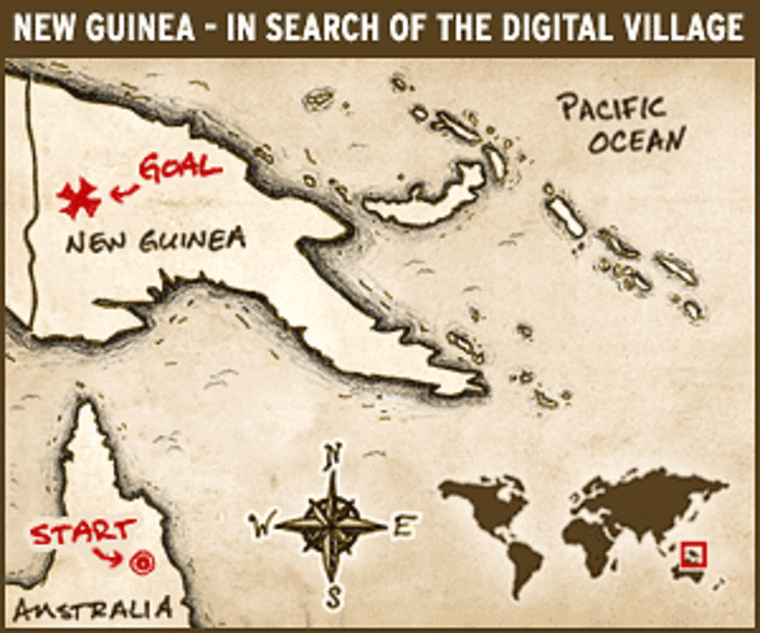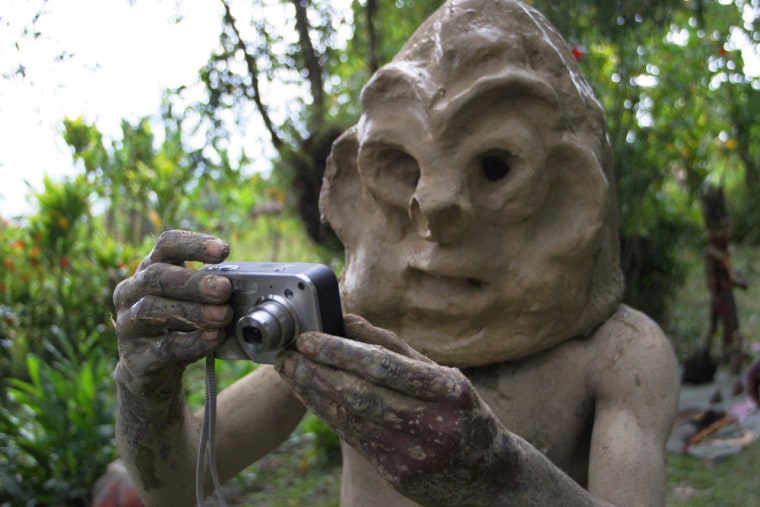Though second largest of all the world’s islands, New Guinea remains among its least-known and little-explored, with an interior still but vaguely charted. Viewed from the air, New Guinea’s massive cordillera appears as a heaving sea of frozen dark-green billows, with feather-white streams tracking the faces of ridges and folds. No roads cross this expanse. It can take weeks to trek from one village to the next, and it is impossible to travel in a straight line. Even today New Guinea conjures up visions of headhunters, cannibals, malarial and leech-infested swamps, and explorers being swallowed up by the land.
And yet it is a photographer’s paradise. Orchids grow like weeds, tropical birds boast rainbows as tails, and the people decorate themselves as living art.
Our quest to find the Digital Village is a journey through the richest rainforest in the world, across a remote and forbidding land to a village whose impenetrability has preserved its mysteries from the leveling scrutiny of the outside world, and has kept its people innocent of the digital world beyond its horizons. When we reach our destination, cameras and an Internet audience in tow, we’ll turn the mirror around and let the objects of our curiosity take a look at us, to see how they see, through their eyes.
New Guinea’s first recorded contact with European civilizations came during that first flush of world discovery, when Portuguese mariner Jorge de Meneses landed on Waigeo Island, off the southern coast of the main island in 1526. He called it Ilhas dos Papuas, the island of the fuzzy-haired men. In 1545 his countryman Ynigo Oritz de Retes sighted the 1800-mile-long mainland and called it Nueva Guinea, after the colony of Guinea in Africa. Over the next 300 years, occasional seamen on their way to somewhere else—the rich trade routes with Siam, Malaysia and India passed close by—charted the outlines of New Guinea; but cordial contact with its inhabitants was rare, and penetrations into the interior unknown.
An isolated island
Missionaries and gold miners prospected for souls and stones up the major watersheds, but even as late as 1930 few had penetrated the precipitous mountain ranges that rim the heart of the 400-mile-wide island. The region was rumored to be uninhabitable, a wasteland of jagged limestone, impossible mazes of jungle and gorge, and rampaging rivers impossible to ford.
In 1930 two Australian prospectors, Mick Leahy and Mick Dwyer, took a wrong turn in the irregular topography of the limestone regions and wound up making a complete traverse of the island, over hidden passes in the rugged high mountains, through tribes that had never seen white men before. It was the last known “first contact” on earth.
Although the physical barriers of the island accounted in part for the slow progress of Western contact, so, too, did the fierce reputation of the Papuans. They were, after all, headhunters and cannibals, and supremely isolated from the trends and tides of world history. As a result New Guinea has provided the most pristine conditions for anthropological research anywhere. The list of influential anthropologists who have done field work in New Guinea reads like a Who’s Who of ethnology: Bronislaw Malinowski, Margaret Mead, Gregory Bateson, Roy Rappaport, and others engaged in over 400 research projects since 1899—to say nothing of Michael Rockefeller, young son of New York Governor Nelson Rockefeller. Michael collected primitive art and worked on two well-regarded documentaries before disappearing off the southwestern coast of the island, in 1961, under mysterious circumstances. To this day, some believe he was eaten by the cannibals of the Asmat coast.
Images of encounter
New Guinea and its photographic wonders have graced many pages in “National Geographic” magazine and large-format picture books. We have been exposed, although only by glimpse, to some of these vivid peoples and their art and architecture, their dance and drama; and we have been drawn in by these images, delighted and provoked, seeking comprehension of a world so different from our own.

But what do the Huli Wigmen of New Guinea see when they meet us? What do these isolated jungle highlanders find enchanting in their lives? What does the world look like through their eyes? Digital Village: New Guinea will turn the lenses around, and allow the peoples of interior New Guinea to show us what they see, to express themselves through the tools of digital cameras in a way never before possible.
With a team of veteran explorers and photographers we will head out to find what we are callling “the digital village.” We’ll first spend time with the Pamagirri Aboriginals in Australia, an ethnic group related to some in nearby New Guinea, who have become a part of the modern world, but who continue to celebrate their heritage.
Telling moments
Then we’ll fly north to Mount Hagen in the highlands of Papua New Guinea, and begin our trek to a place where the villagers have rarely had contact with the outside, and still practice ceremonies and traditions that date back centuries. It will take many days to reach the Digital Village, and the expedition will be a grand adventure in and of itself, photographed and reported in virtual real-time on the Internet.
When and if we arrive we will equip the villagers with digital cameras and a photo printer, all provided by our sponsor Hewlett-Packard. We plan to enable the village men who run the councils, the women who work the fields, the children who learn their life skills from the lead of their elders, to document their lives and interests for the world. We’ll ask them to shoot what they find interesting, valuable, beautiful; we’ll ask them to photograph us, the visitors who have come to their community; we’ll ask them to stage their most colorful ceremonies, and to capture on camera the telling moments of their lives.
Then we will share these images and experiences online, with you.
We’ll complement their efforts with our own images and videos, audio interviews and music, and narrative account. Though satellite uplinks to MSNBC offices in Redmond we’ll publish and distribute the results for the world to see.
We will learn through each other’s visions what those in a very different environment see and feel. We are thousands of miles and centuries apart, but in many ways just a shutter click away.
